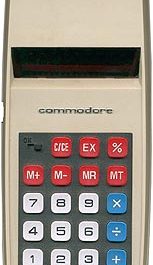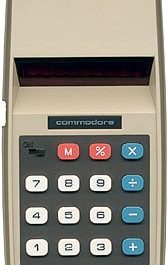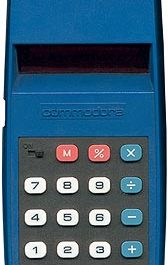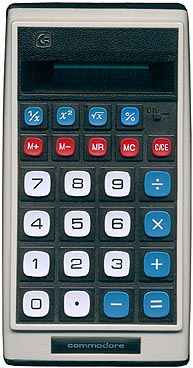
The Commodore 9R-25 calculator, introduced circa 1976, is a great example of the technological advancements in personal computing devices of its era. Manufactured by Commodore, a company renowned for its contributions to the computing industry, this calculator offers a blend of functionality and aesthetic design that captures the essence of the mid-1970s.

Design and Construction
The Commodore 9R-25 features a sturdy, three-piece case constructed from black and white matt plastic. The top front of the calculator is adorned with an oversized green plastic display filter, which is flush with the case and features a sloping inset section. This design element not only enhances the visual appeal but also ensures a bright and clear image on the display. The Commodore logo, raised and painted silver, is prominently featured, adding a touch of brand recognition.
The calculator’s keys are boldly colored in red, white, and blue, each with its own raised surround. While the keys may feel somewhat wobbly and squishy, they are functional and responsive. Below the keyboard, a black printed metallic sticker bearing the company name sits in its own recess, further enhancing the device’s overall aesthetic.

Display and Features
The Commodore 9R-25 boasts an 8-digit green Vacuum Fluorescent Display (VFD) with a ninth digit reserved for indicating negative numbers, memory status, and error messages. This calculator offers standard four-function capabilities, along with additional features such as percentages, reciprocal calculations, squares, square roots, and a four-function memory.
Power and Dimensions
Powered by 4.5V DC internal sealed batteries, the Commodore 9R-25 includes a rechargeable Ni-Cd battery pack. The adapter (type No. DC-420B, centre positive) is used to recharge the built-in batteries, with the socket located on the right-hand side, just above midway. The calculator’s dimensions are approximately 78mm (max) x 140mm x 28mm (max) (width, height, depth), and it weighs 164g including the in-built rechargeable batteries, or 188g without them.
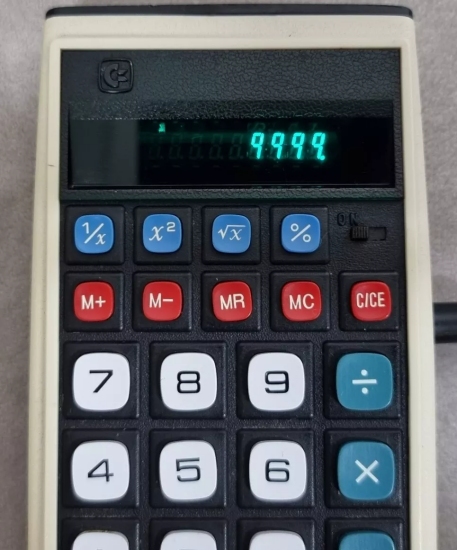
Internal Components and Construction
The main CPU board (Part No. 201101, made in Japan) sits atop the keyboard assembly (201 098 76 430) and is secured by the adapter socket. The two components are connected by a long 14-way ribbon cable, with the keyboard assembly fixed to the front with ten screws. The calculator’s internal components include a MOS MPS7545 003 1976 CPU, a 9-digit VFD, two transistors, six diodes, four capacitors, four resistors, two resistor arrays, a transformer, and a double AA-sized rechargeable battery pack.
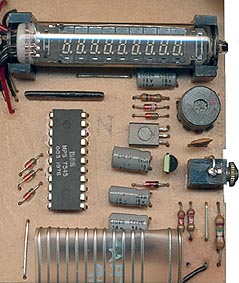
Logic
- (C/CE) is used on the first press to cancel the last number entered and the second to clear the whole calculator.
- Input overflow is suppressed; inputting a ninth digit is ignored.
- Negative numbers show a “-” sign in the far left (ninth) digit, allowing full eight-digit negative numbers.
- Overflow shows the result and “C” (if positive or negative) in the far left (ninth) digit and is not recoverable.
- Divide by zero shows zero and “C” in the far left (ninth) digit and is not recoverable.
- Automatic constant is available on all four functions.
- Negative square roots are not allowed; the result is shown as an unrecoverable error.
- Memory store is indicated by the far left (ninth) digit’s decimal point.
- Overflow in memory keeps the original number rather than storing the erroneous result, which it displays.
- It has the negative zero bug: key in (1)(-)(2)(=) to give “-1,” then (+)(1)(=) will give you “-0.”
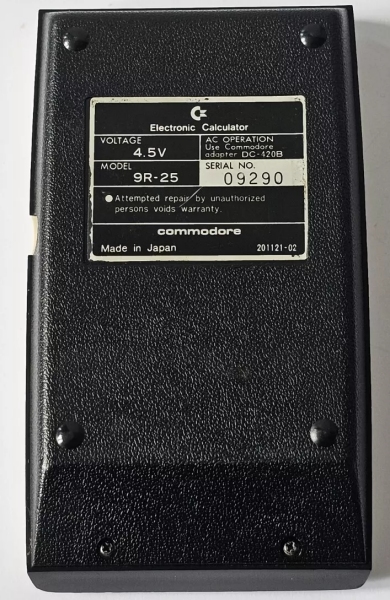
Summary
The Commodore 9R-25 calculator is a testament to the technological advancements of the 1970s, offering a blend of functionality and aesthetic design. While its logic is generally sound, it is somewhat let down by the lack of recovery from errors and the negative zero bug. Nonetheless, its bold and simple design, coupled with its comprehensive feature set, makes it a notable addition to the Custom Green Line series of calculators.
